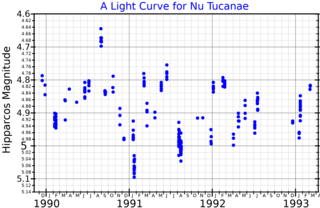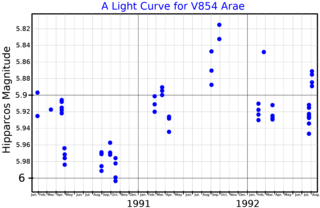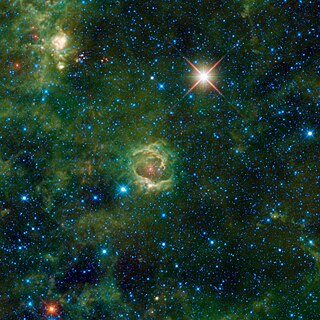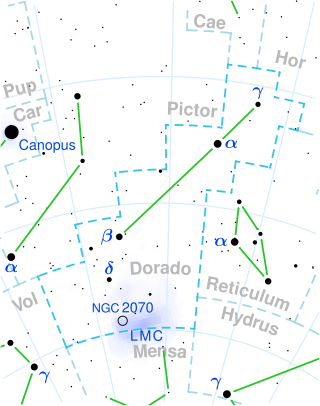
ν Tucanae, Latinized as Nu Tucanae, is a solitary, variable star in the southern constellation of Tucana. This red-hued object is visible to the naked eye as a faint star with an apparent visual magnitude that fluctuates around +4.80. It is located approximately 290 light years from the Sun based on parallax, but is drifting closer with a radial velocity of −3 km/s.

ν Virginis, Latinized as Nu Virginis, is a single star in the zodiac constellation of Virgo, located at the western tip of the classic constellation and nearly due south of the prominent star Denebola. It is a red-hued star with an apparent visual magnitude of 4.04 and can be seen with the naked eye. Because the star lies near the ecliptic it is subject to occultations by the Moon. Parallax measurements provide an estimated distance of around 331 light years from the Sun, and it is drifting further away with a radial velocity of +50 km/s.

Omicron1 Canis Majoris is a red supergiant star in the constellation Canis Major. It is also a variable star.

Psi1 Aurigae is a star in the northern constellation of Auriga. It is faintly visible to the naked eye with an apparent visual magnitude of 4.91. Based upon a measured annual parallax shift of 0.44 mas, it is approximately 7,500 light-years distant from the Earth. It is receding from the Sun with a radial velocity of +4.7 km/s.

V520 Carinae is a single star in the southern constellation of Carina. It has the Bayer designation w Carinae, while V520 Carinae is a variable star designation. The star has an orange hue and is faintly visible to the naked eye with an apparent visual magnitude that fluctuates around +4.58. It is located at a distance of approximately 1,140 light years from the Sun based on parallax, and it is drifting further away with a radial velocity of +9 km/s. It is a candidate member of the IC 2391 moving group of co-moving stars.

Kappa Cassiopeiae is a star in the constellation Cassiopeia.

4 Cassiopeiae is a red giant in the northern constellation of Cassiopeia, located approximately 790 light-years away from the Sun. It is visible to the naked eye as a faint, red-hued star with a baseline apparent visual magnitude of 4.96. At the distance of this system, its visual magnitude is diminished by an extinction of 0.56 due to interstellar dust. This system is moving closer to the Earth with a heliocentric radial velocity of −39 km/s.

DL Crucis is a variable star in the constellation Crux.

HD 155035 is a star in the constellation Ara, the Altar. It is located at a distance of approximately 1,450 light-years from Earth and has an apparent visual magnitude of 5.92, making it is faintly visible to the naked eye. This is a red giant star with a stellar classification of M1.5 III.

NO Aurigae is a pulsating variable star in the constellation Auriga. It is an unusually-luminous asymptotic giant branch star about 3,500 light years away. It is a 6th magnitude star faintly visible to the naked eye under very good observing conditions.

6 Cassiopeiae is a white hypergiant in the constellation Cassiopeia, and a small-amplitude variable star.
145 G. Canis Majoris is a single K giant or supergiant star in the southern constellation of Canis Major. This star is Gould's 145th of Canis Major in his Uranometria Argentina. Kostjuk erroneously lists it as simply "145 CMa". SIMBAD follows this error in its object query result as "* 145 CMa – Star".

PZ Cassiopeiae is a red supergiant star located in the constellation of Cassiopeia, and a semi-regular variable star.

V1073 Scorpii is a variable star in the constellation Scorpius. It has a non-Greek Bayer designation of k Scorpii. The star has a blue-white hue and is visible to the naked eye with an apparent visual magnitude that fluctuates around +4.87. Parallax measurements yield a distance estimate of approximately 2,920 ly (896 pc) from the Sun, and it is drifting further away with a radial velocity of +7 km/s. It has an absolute magnitude of −6.8

V419 Cephei is an irregular variable star in the constellation of Cepheus with an apparent magnitude that varies between 6.54 and 6.89.

QY Puppis is a K-type supergiant star in the constellation of Puppis. With a radius of 515 R☉, it is on the smaller end of the largest known stars. A variable star, its apparent magnitude varies from 6.24 to 6.71, making it very faintly visible to the naked eye under ideal observing conditions, when it is at its brightest.

AF Columbae, also known as HD 42682, is a solitary, red hued variable star located in the southern constellation Columba, the dove. It has an apparent magnitude that fluctuates between 5.6 and 5.71. Nevertheless, it is faintly visible to the naked eye. Parallax measurements from the Gaia spacecraft place the star relatively far at a distance of 820 light years. However, it is approaching the Solar System with a poorly constrained radial velocity of −19 km/s.

V718 Coronae Australis is a solitary variable star located in the southern constellation Corona Australis. It is faintly visible to the naked eye as a red-hued point of light with an apparent magnitude of 5.43. Gaia DR3 parallax measurements imply a distance of 630 light years and it is currently receding with a heliocentric radial velocity of 28.5 km/s. At its current distance V718 CrA's brightness is diminished by 0.37 magnitudes due to interstellar dust and it has an absolute magnitude of −1.03.

HD 11928 is a solitary star located in the northern constellation of Triangulum. It is faintly visible to the naked eye as a red-hued point of light with an apparent magnitude of 5.85. Gaia DR3 parallax measurements imply a distance of 530 light-years and it is drifting closer with a heliocentric radial velocity of −1.93 km/s. At its current distance, HD 11928's brightness is diminished by an interstellar extinction of 0.13 magnitudes and it has an absolute magnitude of +0.11.

HD 271182, occasionally referred to as G266 and R92, is a rare yellow hypergiant (YHG) and an Alpha Cygni variable. It is one of the brightest stars in the Large Magellanic Cloud (LMC), positioned in the deep southern constellation of Dorado. Gaia DR2 parallax measurements indicate that it is located around 200,000 light-years away, though this value is extremely uncertain. Despite this vast distance from Earth, the star is observable through a small telescope due to its immense luminosity, at an apparent magnitude of 9.6. It is receding away from the Sun at a heliocentric radial velocity of +311.9185 km/s, confirming its membership in the LMC.


















